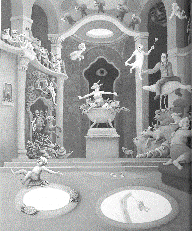Liel Leibovitz - Staff Writer

The new exhibit at the Yeshiva University Museum is one of the most
remarkable artistic representations of the Holocaust mounted in recent
years. And it is even more remarkable considering that the artist,
Valentin Lustig, was born a decade after the end of the Second World
War, and that his colorful paintings display none of the somber hues
and stormy brush strokes often associated with Holocaust paintings.
Instead, Lustig’s canvases are bold and rich in detail, with a touch of
surrealism and a strong emphasis on symbolism. As such, they provide
the viewer with a complex, almost dualistic experience. At first, one
is likely to feel stunned by the cornucopia of sheep, goats, fish and
cats nearly omnipresent in Lustig’s work, overwhelmed by the painter’s
packed narratives that offer an array of rich and strange small scenes
unfurling before the eye.
Then, however, the decoding begins: Lustig offers his viewers the
immense pleasure of weaving a seemingly unrelated chaos into a web of
meaning.
Take, for example, his startling work, “The Letter Soup (We Are Near).”
A family sits around a table eating flaming red soup with letters in
it, while in the background men and beasts, including a gigantic cat,
perch, and the ground is paved with a flock of dead fish and
quizzical-looking seagulls.
It’s the letters in the soup that begin to unravel the enigma: “Nah
Sind Wir,” or “we are near.” This is the opening line from a poem by
Paul Celan, the famous Jewish poet who hails, like Lustig himself, from
Romania. The most famous lines from the poem declare, “It was blood, it
was what you shed, Lord / It gleamed / It cast your image into our
eyes, Lord. / Our eyes and our mouths are open and empty, Lord.”
The red soup, then, is blood. The oversized cat ceases to be a fanciful
creation; now, he is an enormous beast looming over the heads of the
huddled masses. The fish, longtime symbols of Christian theology, are
all dead. The excellent catalog that accompanies the exhibit makes
Lustig’s intention perfectly clear: Like Celan, Lustig writes, he, too,
used his art to explore a most troubling question, that of the lost of
faith in the face of the horrors of the Holocaust. This is why the
letters — the only way, according to Jewish tradition, with which to
render the image of God — are slowly consumed in the bloody soup, as
Lustig and Celan’s faith was consumed after having witnessed or learned
about the mass murder of their kin.
Despite not having lived through the war, Lustig nonetheless
experienced it firsthand. He is the son of survivors, born into a
family that lost 55 of its members to the Holocaust. He himself, the
catalog informs us, is a “replacement child,” named after an uncle who
perished in Auschwitz.
And it is replacement in the widest sense of the word that guides some
of Lustig’s work. In “Hoka-Neni,” for example, a series of seven
paintings devoted to his dead aunt that constitutes the heart of the
exhibit, Lustig quotes, paraphrases and adapts. “The Temptation of
Hoka-Neni,” the fourth painting in the series, is the most striking
example, quoting both from Gustave Flaubert’s “The Temptation of St.
Anthony” and from an Hieronymus Bosch painting of the same name, Lustig
paints his aunt kneading bread in her kitchen while all around her
terrifying creatures roam. Unlike St. Anthony, however, the aunt is
surrounded not only by monstrous creatures and demonic beings, but also
by more concrete omens, such as a rolling Panzer tank, as well as by
purely symbolic ones, such as a meat grinder. Her question, however,
remains the same one that the saint, in exile in the Egyptian desert,
pondered: why does God do bad things to righteous people?
In a time in which “The Da Vinci Code” and its likes spread the gospel
of symbolic, pseudo-religious hokum, Lustig’s work is a delightful
opportunity to ponder theology’s most difficult questions while
rejoicing in art’s greatest gifts. n
“The Holocaust in the Paintings of Valentin Lustig” will run until Jan.
14, 2007, at the Yeshiva University Museum, 15 W. 16th St. (212)
294-8330. Call for pricing and schedule. |


